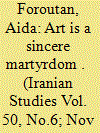| Srl | Item |
| 1 |
ID:
155084


|
|
|
|
|
| Summary/Abstract |
This paper focuses on various aspects of Alireza Espahbod’s style of painting that encrypt his work. The period considered is from the just after the Iranian revolution until the artist’s death in 2007: in these years censorship had become severe, resulting in banning prohibition on his work being exhibited. Apart from the striking symbols that recur throughout his work, it is noticeable that he favors certain visual metaphors for encryption of humanitarian and satirical meanings. The discussion also focuses on the ways in which sequences of his individual paintings create narratives, like scenes in a play or a film. Unlike some preceding modernists, Espahbod is firmly rooted in his Iranian cultural milieu, and is in a line of artists who have used surrealism, beginning with Sadegh Hedayat in the modern literary world. He also follows a much older tradition that goes back to classical poetry and miniature art, in which image and word coalesce and are interchangeable, and where literature and visual art reflect one another. He uses these older techniques to comment allusively on the dramatic events and conditions of his own time. It is argued that his work amounts to more than that of an artist who merely fought against censorship, as his art rises above it and responds to it with a positive message for his audience.
|
|
|
|
|
|
|
|
|
|
|
|
|
|
|
|
| 2 |
ID:
145924


|
|
|
|
|
| Summary/Abstract |
In Iran surrealism is spoken of by artists and critics as a living element in art, long after its popularity in Europe and North America has waned. This article explores key features of the work of one of the most prolific contemporary Iranian artists, Ali-Akbar Sadeghi. While Sadeghi says that he thinks of himself as a “surrealist,” his work is distinguished from many self-professed surrealists in Iran: whereas the latter are concerned with representing metaphysical, even mystical, meanings, Sadeghi sees his art as a kind of intellectual exercise, presenting a dramatic theater in which the viewer engages in epistemological interrogation. Though Sadeghi's paintings are full of apparent references to surrealist themes and tropes from the past, here it is argued that his work is not so much a storehouse of surrealist content as a series of puzzles for the viewer to solve.
|
|
|
|
|
|
|
|
|
|
|
|
|
|
|
|